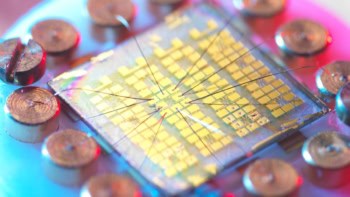Physicists have succeeded in "entangling" more than two photons for the first time. A Canadian team has entangled three photons while an Austrian team have created a four-photon entangled state. The wavelengths of the entangled states are three and four times shorter than the original wavelengths of the photons. By overcoming the so-called diffraction limit, entangled photons could prove useful in a range of applications ranging from lithography to microscopy (Nature 429 161 and 158).
Entanglement is a feature of quantum mechanics that allows particles to be correlated in ways that are not possible in classical physics. If two particles are entangled, then we can determine the properties of one by making a measurement on the other, no matter how far apart they are. For instance, photons can be entangled so that if one photon is vertically polarized, the other will always be horizontally polarized, and vice versa.
Physicists routinely entangle pairs of photons using a technique called ‘parametric down-conversion’. By shining a laser on a crystal with nonlinear optical properties, one photon can be “split” into two entangled photons. Now, Aephraim Steinberg and co-workers at the University of Toronto and Anton Zeilinger and colleagues at the University of Vienna have used this principle — but different experimental techniques — to produce entangled states of three and four photons respectively. These states have wavelengths of λ/N, where λ is the wavelength of a single photon and N is the number of entangled photons. Both teams say that their schemes are, in principle, extendable to higher values of N.
These results could, for example, lead to faster computer chips. Transistors and other features in chips are made using optical lithography, where light etches out patterns on a photosensitive substrate on silicon. The minimum feature size possible is approximately equal to the wavelength of the light used. This is the “diffraction limit”. By using entangled photons it could be therefore be possible to significantly reduce the minimum feature size.



